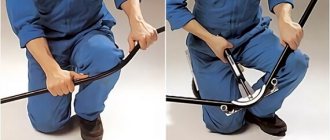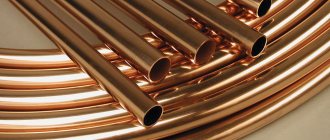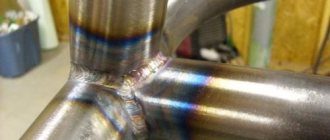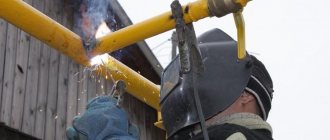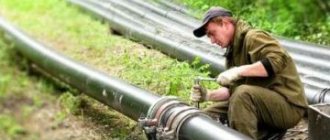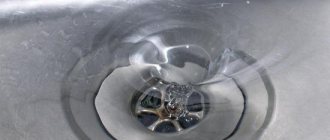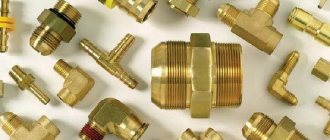Steel pipes are widely used in industry, construction and individual housing construction, laying heating and gas lines inside the house, and installing chimney pipelines. In many cases, corrosion-resistant zinc-coated pipelines are used, the main method of joining which is welding galvanized pipes.
Performing welding work on products with a zinc layer differs from similar operations with ordinary steel without a protective shell; knowledge of the nuances will help to obtain a high-quality welded joint, correctly select the operating modes of the device, types of solders, fluxes and welding electrodes for gas and electric arc welding.
Rice. 1 Welding galvanized pipes
What is the difference between galvanized pipes and ordinary ones?
About 60% of the zinc extracted from the bowels of the earth by the mining industry is used in the production of galvanized rolled products, another 20% is used for galvanizing metal structures (automotive and industrial equipment bodies, building materials), machine parts and mechanisms.
The difference between structural steel and non-corrosion metals (tin, aluminum, lead, zinc) is that the latter, when oxidized in air, forms an oxide, which in the form of a protective film becomes a barrier to the access of oxygen to the metal. Thus, the film prevents further oxidation and protects the metal from corrosion destruction. Iron, unlike non-ferrous metals and alloys, during corrosion forms a loose hydroxide of large volume, as a result of which oxygen easily penetrates to its surface and the oxidation process continues.
The zinc coating applied to the surface of the steel protects the iron from contact with oxygen - thus, its corrosion protection is significantly increased and the galvanized product can be used for an average of about 50 years.
The essence of the technology is that, from an electrochemical point of view, iron forms a galvanic couple with zinc, in which the more active zinc enters into a corrosive interaction with oxygen first, leaving the iron in a chemically passive state. In a similar way, you can significantly accelerate the corrosion of iron if you apply tin, which is a more passive element in a galvanic pair with iron, to its surface and damage its shell.
Metal pipes made of any grade of steel are subjected to galvanization, covering not only their outer but also the inner surface, while the highest quality and homogeneous layer is obtained in seamless rolling. Various technologies are used to apply zinc, which can be used not only on an industrial scale, but also in small private production - many commercial companies are engaged in galvanizing steel parts to order.
Application of protective coating
Restoration of galvanization in a factory workshop is carried out using cathode sputtering. The process is of an electrochemical nature and is therefore not applicable in field conditions. When installing household communications, an alternative protection is painting the pipes. The coating requires constant monitoring and renewal when pipes rust.
We recommend that you read: How to assemble and install a chimney from a sandwich pipe for a bathhouse with your own hands
Paint with a zinc dust content of more than 90% has a more lasting protective effect. Apply it using an ordinary brush. There is a way to restore the zinc coating by fusing chemically pure zinc wire onto the joint surface.
Methods of galvanizing steel
For galvanizing rolled pipes, specialists have developed several methods that differ significantly in the application process, layer thickness and coating quality. Galvanized pipes, unlike base rolled steel, have better corrosion resistance, but their physical characteristics are no different from steel products, so they are subject to standards for gas and electric welded pipes.
Rice. 2 Hot-dip galvanizing
Hot galvanizing
Coating steel surfaces inside and outside with molten hot zinc is the most common method for pipes up to 8 meters in length; the technology is widely used in the national economy at large machine-building enterprises.
For galvanizing in a factory, during the preparation of products, degreasing with alkalis and etching in solutions of sulfuric and hydrochloric acids are used; for fluxing, solutions of ammonium chloride or zinc are heated to 40 - 50º C. The further process consists of lowering the pipes into a bath of zinc melt at a temperature of 460º C - the zinc binds with oxygen, and the resulting ZnO oxide, after reacting with carbon dioxide CO2, forms a protective film of ZnCO3 carbonate.
This gray material has a matte surface, high mechanical hardness and adhesive strength, distinctive features of hot-dip galvanizing (HZ):
- The standard thickness of the zinc layer is 50 - 70 microns on the outer surface and 80 - 100 microns on the inner surface; if damaged, it is capable of self-healing.
- Corrosion resistance is close to stainless alloys, the service life of coatings on rolled metal in the industrial sector is 65 years, outside the city - up to 120 years, when using galvanized pipelines for water supply in heating systems, their service life is 15 - 25 years.
- Low-carbon steel pipes with a diameter of 17 - 160 mm and a length of 6 to 12 m are hot coated with zinc.
- The main disadvantage of the method is some unevenness of the layer (sagging) along the length and perimeter of the pipes.
Rice. 3 Galvanized
Related article:
How to weld a pipe with water - several proven options . Reading about how to weld galvanized pipes, it may be interesting to read about how you can weld a pipe with water. Sometimes it is very necessary to do something when a pipe is leaking and you can’t turn off the water.
Galvanic (electrolytic) galvanizing method
The technology occupies a leading position in the coating of various types of parts of complex shapes; dissolved zinc has an electrochemical effect on the metal surface, which, through an electrolytic solution, enters the parts being processed and is deposited on their surface. To do this, a steel element (cathode) is placed in a bath with an electrolyte, zinc plates (anode) are placed at the other end and a direct current is supplied to them, with a negative potential on the part and a positive potential on the zinc plate.
Electrolytic galvanizing technology (EC) has the following features:
- Depending on the time the workpiece is in the electrolytic environment, the thickness of the zinc layer can be adjusted, which is usually 20 - 30 microns.
- The products have a beautiful decorative appearance with a glossy surface of silver, bluish or yellow tint; with some technologies they also obtain a matte finish.
- Using the electrolytic method, it is possible to spray metal parts combined with elements made of other materials on which zinc is not deposited (plastics).
- The disadvantages of the method include insufficiently high adhesion and the need to dispose of the used electrolyte with a high concentration of hazardous chemical waste - as a result, the cost of the electrolytic method is higher.
Rice. 4 Chambers for TDC sputtering
Thermal diffusion galvanizing (TDG) by spraying
The technology is based on the diffusion deposition of zinc, which is in a vapor state and heated to a high temperature, into the protected steel surface. To do this, the workpiece is placed in special processing equipment - a hermetically sealed chamber, and a temperature of 290 - 450º C is created in it (the method is called sherardization), while the powdered zinc goes into a gaseous state and its atoms diffuse into the surface layer of the part.
Another type of technology is the processing of parts in zinc vapor at temperatures of 800 - 900º C, distinctive features of the methods:
- High cost, almost twice as much as that of hot-dip galvanizing technology. • Possibility of adjusting the thickness of the protective layer in a wide range, the average value of which is about 40 microns.
- The protective coating has a dense structure and high adhesion to the steel surface, its protective properties are 5 times higher than those of galvanic galvanization.
- The technology is environmentally friendly, since the process takes place in a closed chamber, and there are no harmful emissions into the atmosphere or sewer system.
- The disadvantages include the not very aesthetic appearance of the products, having a dirty gray color, low productivity and heterogeneity of the coating.
Rice. 5 Gas-thermal coating method
Thermal spraying
This technology is used to apply a protective zinc coating to parts that need to be protected or repaired at any location. The essence of the method is to apply zinc, in powder form or in the form of a cord or solder, to the surface of the workpiece by placing it in the gas jet of a burner. Particles of gaseous molten zinc, hitting a steel surface heated to a temperature of no more than 150º C, form a shell on it in the form of scales, protecting the iron from corrosion.
Unlike GC coatings, thermal spraying chips more easily and does not have the ability to self-heal in damaged areas. Typically, products galvanized by this method are coated with paints and varnishes; the thickness of the zinc layer reaches 200 microns or more.
Cold galvanizing
The technology has gained popularity recently; it is successfully used in everyday conditions - processing does not require special equipment or the use of complex technical processes. The essence of the process is that a zinc-containing composition (Zinconol, Galvanol) with 89 - 93% zinc is applied to the surface to be treated, using an ordinary construction brush, roller or spray gun; the drying process of one layer takes no more than 30 minutes.
The method is convenient to use in cases where the metal structure cannot be moved or dismantled; car enthusiasts use cold galvanizing for body repairs. Disadvantages include low resistance to mechanical stress and petroleum products (gasoline, kerosene, machine oils).
Rice. 6 Cold galvanizing
Is welding of galvanized pipes allowed and its features?
The main problem when welding galvanized steel pipelines is the presence of a coating that prevents fusion. Since the boiling point of zinc is 906º C, and the weld seam is heated to 1200º C, during welding the zinc burns out and only after this does the steel join. Carrying out welding work with galvanized steel has the following features:
- Welders with little experience are not always able to weld the zinc shell evenly and get a good, even seam - in order not to create additional problems, before welding it is easier to remove the protective layer of the coating using a grinder with a metal disc, a file or sandpaper. Chemicals are also used for this - galvanizing can be removed using solutions of hydrochloric, nitric and sulfuric acids.
- Zinc fumes cause significant harm to human health and have a sweetish taste, so the following requirements of safety regulations (HS) should be observed before performing welding work. It is necessary to provide the workplace with flowing ventilation, without which the welder is prohibited from working according to safety regulations, and to use means to protect the respiratory tract from zinc fumes.
- Standard welding methods lead to damage to the zinc layer, the seam remains unprotected and the overall corrosion resistance of the entire welded structure is significantly reduced. For subsequent seam protection, it is better to use similar zinc-containing cold galvanizing compounds, the technology and materials for which are described above.
- Sometimes, due to intense evaporation of zinc, the surface of the pipe becomes covered with small cracks; to prevent this effect, it is useful to use fluxes. The main purpose of welding fluxes is to isolate the seam surface from oxygen, stabilize the arc, form a weld seam and alloy to enrich the seam joint with metal.
Video description
Listen to the master's recommendations and watch his work in this video to better understand the process:
Gas welding with flux
Welding galvanized steel can also be carried out with a gas torch. To prevent it from burning the zinc layer, special high-temperature fluxes are used - pastes, which are applied to the surface to prevent it from overheating and melting the galvanization into a gaseous state.
The flux layer absorbs part of the thermal energy. The layer of zinc underneath melts to a viscous fluid state, spreads and covers the pipe joint, creating a protective cover.
Flux for galvanized steel, bronze, brass Source walmartimages.com
Technologies for welding galvanized pipes
To connect galvanized pipes, you can use devices and technologies similar to methods for welding conventional low-carbon steels. To connect parts in domestic conditions, gas acetylene with oxygen or propane-butane welding is used, as well as electric arc welding, based on the principle of exposure to high-temperature plasma arcs on metal. The main methods of joining pipes using an electric arc are:
- Manual welding. It is implemented by igniting an arc between the electrode and the metal by applying voltage to them from an electric welding machine; the electrode melts when welding elements, forming a connecting seam.
- Welding with a non-fusible electrode. Welding is carried out with a tungsten electrode in a gas protective atmosphere (argon, helium, nitrogen or mixtures thereof) using metal wire additives, the English name of the process is tungsten inert gas welding (TIGW).
- Semi-automatic welding with fusible electrode in a gas environment. There are two types of automated welding, with inert gas (MIG) and active gas (MAG). During work, the wire electrode is supplied to the welding zone along with gas through a special pistol-type holder.
- Submerged arc welding. When using this technology (English designation SAW), the end of the electrode in the weld pool zone is submerged in a gas bubble - this prevents the penetration of oxygen into the welding zone and increases the depth of heating of the seam.
Rice. 8 Welding with a gas torch - equipment
Welding galvanized pipes with a gas torch
Construction standards GOST 16037-80 allow gas welding of pipes for heating networks with a wall thickness of 1 - 3 mm and an outer diameter of up to 150 mm with unprepared ends.
Gas welding is one of the simplest methods of joining parts; to carry out welding work, it is enough to purchase cylinders with any gas (acetylene and oxygen) and a torch with a hose; wire from the same material is used as an additive for welding steels with low carbon content. Welding low-carbon steel with gas does not require the use of special fluxes used when working with non-ferrous metals (aluminum, copper, brass); the work is carried out in the following sequence:
- Prepare the workpieces for welding by making the necessary gap between the ends of the parts of 1 - 2 mm, chamfering with a grinder and fixing the elements with tacks.
- To improve the quality of the weld, you can use a flux made from a mixture of boric acid and borax, and brass or steel wire (SV-0.8G2S, SV0.8A) as a tack.
- Turn on the gas, adjust the torch flame and bring it to the seam to be welded at an angle of about 60 degrees, holding the rod in front in the direction of movement of the torch at an angle of 30 - 40 degrees (left-hand welding). Unlike right-hand welding, where the torch and rod move towards the welder, the advantage of this method is that the plasma under pressure pushes away the molten metal and the pool moves forward, filling the free cavities.
- At the end of the work, the scale is knocked off, the surface of the seam and the burnt-out area of the product are covered with cold galvanizing.
The main disadvantages of gas welding are:
- Low temperature and, accordingly, the heating rate of the metals being joined, the welding speed drops sharply as the thickness of the materials increases.
- Wide thermal impact zone due to strong heat dissipation.
- High cost of welding compared to the electric arc method.
Rice. 9 Welding galvanized pipes with a torch
Welding with electrodes
In accordance with GOST 16037-80 standards, manual arc (MA) welding, as well as shielding gas welding with consumable electrodes (MIG), are allowed on pipes with the following dimensional parameters and preparation:
- when the edges of two pipes meet with a one-sided weld without a bevel - a wall thickness of 2 - 5 mm. and an outer diameter of at least 25 mm;
- at a joint with a one-sided seam and beveled edges, welding of pipes with a wall thickness of 3 - 20 mm is allowed. with a diameter of 25 mm;
- A corner connection of 2 pipes without beveled edges is permissible with a wall thickness of 2 - 20 mm. and an outer diameter of at least 14 mm. for MIG and 25 mm. for RD.;
- An angled connection of two pipes with straight edges is allowed with a wall thickness of 2 - 25 mm. with a diameter of at least 25 mm. for RD welding and 14 mm. for MIG.
Popular types of electrodes used for welding galvanized steel are rutile and basic; their choice determines the appearance and quality of the seam.
Rice. 10 Electrode structure
Rutile coated electrodes
Rutile electrodes (R) are a coated metal rod, the main component of which is titanium dioxide TiO2 (rutile, 48%), the remaining components are feldspar 30%, magnesite and ferromanganese 15% each, dextrin 2%. The acidic slag produced during welding from hydrogen, carbon and nitrogen oxides protects the seam from air ingress. The addition of cellulose (RC) further increases protection and improves performance, and electrodes are commercially available with two-component coatings of basic and acidic materials (RB and RA, respectively). Sometimes, to increase the mass of welded metal, iron powder is introduced into the structure of the coating; the distinctive features of rutile electrodes are:
- Designed for welding low-alloy and low-carbon steels. • When welding, rutile electrodes are easier to ignite and produce a stable arc (especially at alternating voltage) with a small amount of spatter. • The resulting seam is highly resistant to tearing and fracture, is not subject to cracking, and has a small number of pores. • Slag is easily removed from the seam. • Welding can be done in any spatial position with high humidity and the presence of scale and rust on the surface of the material. • Before using the electrodes, they must be dried and calcined; use is allowed after 24 hours. Galvanized pipes can be welded using electrodes of suitable diameter depending on the distance between the workpieces; there is a huge number of rutile electrodes on the market (MGM 50K, AWS E 6013); specialists use the Monolit RC 3 mm brand for tear-off welding of galvanized steel.
Rice. 11 Principle of electrode welding
Electrodes with basic coating
The composition of the electrodes with the main coating (B) includes magnesium carbonate (marble) about 50%, calcium carbonate 6% (quartz sand), fluorspar 18%, ferromanganese and ferrosilicon 5% each, ferrotitanium or silicomanganese about 12% (the percentage is given for SSSI 13/45 and 13/55 FC). Other brands may differ in composition; the features of electrodes with a basic coating are:
- They are suitable for welding ordinary and alloy steels operated under high mechanical stress and elevated temperatures. They are used to join hardened alloys that are susceptible to cold cracks, thick elements and rigid joints.
- Electrodes absorb moisture well; they need to be calcined before welding.
- They are undemanding to the chemical composition of steel and are used for welding alloys with high concentrations of sulfur, carbon and phosphorus.
- Seam metal has a low content of gases and harmful impurities, and has good elasticity and impact strength.
- The seam is resistant to cracking and hydrogen sulfide cracking, and has low oxidative properties.
- When welding with alternating current, the arc may be interrupted.
- The seam is susceptible to pore formation due to a long arc, high humidity and rust.
Popular brands of electrodes with a basic coating are UONI 13/55, KOBELCOLB-52U, OZL-8, ESAB OK 61.30, for welding without tearing off galvanized pipes with a gap of 1 mm. specialists use LB-52U KOBELCO 2.6 electrodes.
Rice. 12 Welding galvanized pipes with rutile (left) and basic (right) electrodes
Welding methods
There are two technologies for assembling pipelines: galvanized pipes can be welded using an electric arc apparatus and a gas burner.
- For the electric arc method, special electrodes with a basic or rutile coating are used. Pipes with a wall up to 3 mm are welded immediately; if the thickness is greater, the edges of the pipe are blunted and chamfered, leaving the welded thickness. A gap of 2–3 mm is left at the seam site. Welding is carried out while maintaining a current in the range from 100 to 160 A. At a higher amperage, burning of parts is possible; at a low amperage, there is a lack of penetration. First, two or three junction points of two pipes are grabbed so that the gap does not open during the formation of the seam. Electric welding of a zinc-coated surface is carried out using the peel-off surfacing method. Each subsequent point is started with a long delay in the bath of the previous one, it is important that the zinc burns out. For the durability of the weld, the bead of weld metal must exceed the thickness of the pipe by ¼. To connect the beginning and end of the weld, knock off the scale, and then weld the joint again so that a bead is formed, slightly larger than the rest of the seam. Welding galvanized pipes with electrodes ends by cleaning the seam with a metal brush: the joint is well cleaned, there is no need to apply protection to it.
- Gas welding is considered the main method of pipeline assembly in urban environments. It is produced using fluxes and soldering alloys. For this, the UTP 1 alloy is used; it is combined with HLS-B flux, which dissolves in water without forming harmful compounds.
Features of welding galvanized pipes include the correct selection of the torch number and the technique for forming the joint. The soldering process involves melting the solder in the seam area, the flame is directed onto the solder, the liquid metal evenly fills the joint area without damaging the flux-coated zinc coating layer.
The solder thickness for joints with a wall up to 10 mm is equal to half the thickness plus 1 mm; if the wall is thicker, the solder is ½. In one pass, the wall is boiled up to 4 mm; if they are thicker, double penetration is done.
Features of welding zinc pipes
When deciding which electrodes to use for galvanizing, select the desired brand based on the operating conditions of the welded product for further use. Welding is no different from regular welding, with the exception of some nuances:
- The temperature effect on the zinc layer leads to its burnout with the formation of toxic gases, therefore, during welding work, safety precautions must be observed - use flow ventilation and protect the respiratory system from gases.
- Before carrying out work, test welding should be carried out on short sections of pipes to select electrodes and the optimal mode of the power supply device.
- To burn through zinc, additional energy is required, so the current on the welding machine is set 10% more than when welding uncoated steel.
- A better quality seam is obtained when using rutile electrodes (this is well known); when welding with electrodes with a basic coating, zinc further deteriorates the quality of the seam, making its edges torn and uneven. Therefore, it is recommended that before welding with electrodes with the main coating, prepare the site of the future joint - remove the zinc coating with acid or abrasive materials.
Selecting Electrodes
Special requirements apply to electrodes for welding galvanized pipes:
- they should not splash too much to damage the protective coating;
- easy to light;
- form a high-quality seam with low impact strength.
The grade of electrode coating is selected according to the type of steel: for carbon steel you need rutile, for low-alloy steel – basic. The rutile coating contains up to 50% titanium oxide, the most popular brands: ESAB-SVEL OK 46.00, Electric Omnia 46, OZS-12, MP-3, UONI 13/55. Of the electrodes with a basic coating, TML, TMU-21, TsU-5, TsL-20 are used for welding; TsL-39, they contain phosphorus and calcium. The diameter is selected according to special tables depending on the thickness of the pipe being welded and the wall thickness; it must comply with SNiP 3.05.01-85.
The final stage and subsequent processing of the joint
Welded galvanized pipes have a seam that is not protected from corrosion; when welding with gas torches, a significant area of galvanization around the joint burns out - all this leads to poor corrosion resistance of the joint. Before and after completion of welding, processing and smoothing the seam with abrasive materials, the following methods are used to combat corrosion:
- When welding using gas torches, rods made of corrosion-resistant stainless materials (zinc-cadmium, brass) are used.
- To protect the external surface, thermal spraying of zinc or a coating of zinc-containing materials in the form of paint is used.
It should be noted that these methods are effective when using a galvanized pipeline for gas supply; if a coated welded pipe is installed in a heating system, then the zinc layer burned out from the inside no longer protects its surface, and corrosion will occur quite quickly. Therefore, when using zinc pipes for heating, he uses other modern methods of connecting them using fittings.
Rice. 14 Solder-welding connection of parts to a zinc metal surface - appearance
Gas torch welding technology
The method was invented by the Germans and is also known as UTP. Currently, UTP-1 solder is used in gas torch soldering in combination with HLS-B flux. Solder is produced in the form of a rod based on copper and zinc; it is suitable for welding alloys of copper and cast iron.
Preparation for work and soldering
Choose a burner 1-2 positions less than if you were to cook regular steel. There must be more oxygen in the acetylene flame so that the silicon in the solder and the oxygen can combine to form an oxide. It is that important protective element that prevents the evaporation of zinc.
Before cooking, sections of galvanized pipes are heated to a length of 5 cm away from the soldering area. During welding, a solder rod is inserted at an angle of 40° into the joint gap, where it melts and the seam is filled with molten metal. It is better to use the “pull” method, holding the rod not behind, but in front of the burner. The flame does not heat the pieces themselves, but the solder.
Connecting galvanized pipes by soldering and welding
From the above examples it is clear that welding with electrodes and a gas torch leads to the destruction of the zinc protective layer, and if it can be restored from the outside in several effective ways, then the inner surface remains unprotected.
It should be noted that zinc products can be soldered; for this, special fluxes or a solution of concentrated hydrochloric acid are used, which etches away the galvanization. The connection is made using conventional tin-lead solder (PS-60) with a powerful soldering iron; it is clear that its strength does not meet household needs when using soldered pipes in heating lines.
Based on the shortcomings of the two methods of joining galvanized products, an intermediate option was developed that combines their positive qualities - welding and soldering. Its essence lies in the fact that when welding, a gas torch with a lower combustion temperature than an electric arc is used, a stainless additive and fluxes that protect the zinc surface at the point of contact with the flame and around the seam.
We will consider the technology for performing welding and soldering work using the example of using materials from the French supplier of its products to the domestic market, Castolin.
Rice. 15 Braze welding tolerances and torch position
Preparation and soldering
For joining galvanized parts, various Castolin solders are used (18, 18F, 18MF, 18 XFC), the most expensive of them is Castolin 18XFC 2.0 mm on a copper-zinc base (57% copper and 42% zinc) with the addition of silver (1%) has a melting temperature of 870 - 895º C. Such solders are used for high-strength solder welding of alloy and non-alloy steels, galvanized materials, soldering of copper and nickel parts; the domestic analogue of Castolin 18XFC is L-57. The main stages of preparatory work before soldering and welding and its implementation:
- Preparing pipes for connection. If the wall thickness is less than 2.5 mm, a butt joint is used, for values more than 2.5 mm, V-shaped processing is used. The inclination angle of the processed ends of 60 degrees is obtained by mechanically removing the layer by grinding, milling, or manually with a grinder, sandpaper or file.
- Selection of flame. For domestic use, a burner nozzle diameter of 1 - 2 mm is quite enough, with which flame you can weld pipes with a diameter of up to 250 mm with a wall thickness of 2 - 6 mm. To accurately determine the size of the nozzle for solder welding, take its diameter one size smaller than for conventional standard welding.
- Flame adjustment. An acetylene-oxygen composition with excess oxygen is used - in this case, silicon oxides are formed, preventing the evaporation of zinc. An intermittent flame contributes to overheating and evaporation of zinc in areas adjacent to the seam, so its correct adjustment is important - the burner flame must be uniform.
- Soldering technique. To join two edges, the “left” soldering technique is used, in which the solder is in front of the flame, the burner should have an angle of inclination during the passage filling the seam of 15 - 30 degrees, if a remelting seam is made, the angle is set to 70 - 75 degrees. The width of the gap between the parts, the thickness or height of the reinforcement is selected in accordance with Fig. 15.
Rice. 16 Solder welding of galvanized steel
Flux application
Before applying surfacing, galvanized products must be treated with Castolin 18 flux; they cover the external and internal surfaces of the attached parts with a strip of at least 20 mm wide from the end. In addition to protecting zinc with a melting point of 416º C from evaporation, which occurs at 906º C, the color of the flux signals the moment when soldering begins.
When using a special flux for welding, Castolin 18, it makes a transition from a yellow tint to white, and when it becomes transparent, they begin to work.
For wall thicknesses up to 4 mm, a single-pass seam is used; upon completion of work, the outer surface is cleaned with a stainless brush, and the inner surface is washed with water after 24 hours.
Technology of work execution
Mainly taken into account is the wall thickness:
- up to 3 mm - pipes are welded without preparatory work, leaving an allowance in the joint of 2–3 mm.
- over 3 mm - a chamfer is made at the ends of the pipes being welded, blunting the edge by 1.5–2 mm.
The correct choice of current and electrode nozzle diameter are of great importance.
High currents in combination with too small a diameter lead to burning through the galvanized pipe, and in the opposite situation there will be undercooking. Another factor is the speed of movement of the electrode. If it moves slowly, there is a risk of damaging the ends being welded. Excessive speed of electrode movement is fraught with undercooking.
Subsequent processing of the joint
After welding, it is recommended to treat the seam with an anti-corrosion compound specifically designed for galvanized pipes. A good option is paint based on zinc dust. It has good adhesion to metals, protects against corrosion no worse than zinc, and is easy to apply by hand.
Alternative options for connecting galvanized pipes
The main methods of welding galvanized pipelines with welding machines, available in domestic conditions, were listed above; many professional welders have and use expensive devices in their work that allow them to achieve high quality and efficiency of welding work.
When installing pipelines for heating systems without welding, modern technology with good performance is used, which allows you to connect two products made of galvanized pipes using compression fittings, fixed to the surface using a special automatic pressing machine with replaceable nozzles.
Rice. 17 Methods for joining pipes with a squeegee and a Gebo coupling
Pipeline connection without welding
When connecting pipes at home, special threaded couplings, fittings, and bends are used; one of the simple and effective methods is the use of Gebo crimp couplings. All these methods are not suitable for high-quality installation of a heating pipeline - when using threaded adapters, it is necessary to cut threads that damage the zinc layer, and a compression coupling with a rubber gasket is not a very reliable element for use on hot pipes.
Recently, in the construction industry, when installing galvanized pipelines, the technology of foreign concerns Geberit Mapress, Viega, Kan Therm, working on thin-walled pipe products from these manufacturers, has been used. The principle of installation is to install crimp press fittings at the ends of the pipes being connected, which are compressed with automatic pliers.
The crimping process is quite simple and consists of several operations:
- Place a nozzle of the required diameter in automatic pliers and fix its position.
- Place a press fitting on the pipe and insert it into the pliers with the outer sleeve.
- They press the press button, and the automation performs crimping; the execution time takes one to two seconds.
Rice. 18 Application of press fittings for pressing
Use of a semi-automatic device
Semi-automatic MIG and MAG welding in an environment of inert or active shielding gases (argon, helium, carbon dioxide) provides high quality seams and requires less skills from welders than manual arc welding. The equipment includes:
- Transformer or inverter device for supplying current.
- Cylinder with a reducer for gas supply.
- Electrical cables and water hoses.
- Special gun for feeding flux-cored electrode wire.
- A transporting device for a wire electrode wound on a drum, a speed control system depending on its diameter and the passing current.
When carrying out welding work, the welder installs the gun in the welding zone, turns on the gas and presses the handle, the electric arc lights up, the wire is automatically fed to the seam, all that remains is to slightly move the gun to the left or right to fill the channel. In this case, the inert gas performs the functions of the surface layer of a conventional electrode, preventing the access of air to the weld pool in the place where the seam is formed.
The main disadvantage of such a system is its bulkiness - a cylinder, a drum with wire, a welding machine with a hose system take up quite a lot of space, so a semi-automatic system in everyday life is used in a separate workshop, welding transported parts.
Rice. 19 Semi-automatic welding of galvanized pipes - device and principle of operation
Other methods of joining galvanized products
Another way to connect galvanized pipes without heating them is threaded joining. Cutting threads on galvanized pipes is quite difficult, so this method is practiced mainly on products with a small cross-section. In addition, this method is financially more expensive compared to conventional welding. Another important point is that in the thread cutting area the zinc layer will be destroyed, so the pipe will begin to rust faster.
To assemble water supply and heating communications, non-welded sets of pipes with fittings, reminiscent of a construction set, can be used. This kit contains a special coupling with a sealing ring, which is secured with bolts to the groove along the edges of the pipe. Although this method of pipe assembly is not yet widespread in our country, it provides a strong connection and is performed very quickly.
To summarize, we can say that the answer to the question of whether it is possible to weld galvanized pipes will be positive, provided that safety precautions and work technology are followed, as well as experience. Remember that it is very important to avoid overheating of the pipes and evaporation of zinc. These phenomena can be prevented using flux and rutile electrodes. Alternative methods of joining pipes, although they have a right to life, however, are significantly more expensive.

